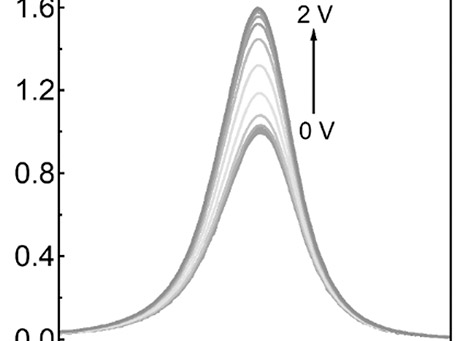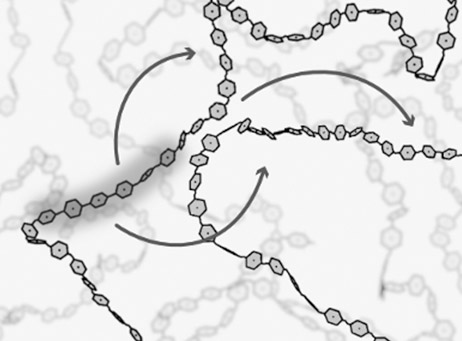Theme 2
Control of Excitons
Realising control over excitons to build new excitonic devices and technology.
Through theory, advanced spectroscopic analysis and new materials, we are getting better understanding and control of the four dimensions of an exciton: Energy, Lifetime, Position and Spin/Polarisation. The outcomes of this theme include new ways to coherently control excitons, new excitonic materials, nanostructure controlled excitonic motifs and new theories of exciton transport.
Excitons are short-lived electron-hole bound pairs which are created when a light particle (photon) interacts with an atom, molecule, nanocrystal or polymer. The conversion of light into electrical energy (in solar cells) and electrical energy into light (LEDs) occurs via excitonic processes, and understanding their properties is essential to the development of new materials that have a higher light-to-electrical-energy conversion efficiency (and vice versa).
In Theme 2 we seek to understand the fundamental processes that govern exciton generation, lifetime and transport across different length scales. This theme comprises three research platforms: Coherent Control of Excitons (Platform 2.1), Excitons at Interfaces (Platform 2.2) and Multiscale Models of Exciton Transport (Platform 2.3).
Platform 2.1 - Coherent control of excitons
Platform Leader: Dane McCamey
Deputy Platform Leader: Trevor Smith
To exploit excitons fully for advanced applications in areas such as optical molecular switching, sensitive magnetometry, and spin-based logic, control over the quantum degrees of freedom (such as phase, super-position and spin) must be established.
In this platform, we are exploring how to control quantum excitonic phenomena, using a range of approaches, including manipulation of spin and optical polarisation. This will provide control over how far, how quickly and to which location an exciton can migrate within a material, and how they interact with each other and their environment.
We seek to understand and control the process of singlet exciton fission, in which two excited states with triplet spin character are generated from a photoexcited state of higher energy with singlet spin character. This process is a pathway to surpassing the Shockley–Queisser limit of photovoltaic cell efficiency, as it allows for more than one exciton to be generated by a single optical excitation.
Recent highlights include the publication of work to characterise the size and spatial correlations of the hyperfine interaction in organic electronic devices. A new femtosecond laser system has been installed that will be coupled with new magneto-cryo-optical capabilities to facilitate methods for mapping exciton behaviour and controlling exciton logic.
People
Chief Investigators
| Name | Node |
|---|---|
| Ken Ghiggino | University of Melbourne |
| Salvy Russo | RMIT University |
| Dane McCamey | UNSW Sydney |
| Jared Cole | RMIT University |
| Trevor Smith | University of Melbourne |
| Wallace Wong | University of Melbourne |
| Girish Lakhwani | University of Sydney |
Associate Investigators
| Name | Node |
|---|---|
| Chris Ritchie | Monash University |
| Jon Beves | UNSW Sydney |
| Colette Boskovic | University of Melbourne |
| Anita Ho-Baillie | University of Sydney |
| Joanne Etheridge | Monash University |
| James Hutchison | University of Melbourne |
| Greg Scholes | Princeton University |
| Kakkudiyil George Thomas | Indian Institute of Science Education and Research |
| Kavan Modi | Monash University |
Postdoctoral Research Fellows
| Name | Node |
|---|---|
| Pria Ramkissoon | University of Melbourne |
| Igor Lyskov | RMIT University |
| Christopher Hall | University of Melbourne |
| Rugang Geng | UNSW Sydney |
| Jamie Laird | University of Melbourne |
| Christopher Bailey | UNSW Sydney |
| Thomas MacDonald | UNSW Sydney |
| Rohan Hudson | University of Melbourne |
| Renzo Fenati | Monash University |
Postgraduate students
| Name | Node |
|---|---|
| Roslyn Forecast | RMIT University |
| Jack Heywood-Day | University of Melbourne |
| Danni Luo | University of Melbourne |
| Engin Akinoglu | University of Melbourne |
| Yang Xu | University of Melbourne |
| Adrian Mena | UNSW Sydney |
| Miles Collins | UNSW Sydney |
| Victoria Esson | University of Melbourne |
| Mayank Bhasin | University of Melbourne |
| William Pappas | UNSW Sydney |
| Hugh Sullivan | RMIT University |
| Roberto N. Muñoz | Monash University |
| Subhajit Chakraborty | University of Melbourne |
| Sakuya Mori | University of Melbourne |
| Nicholas Sloane | UNSW Sydney |
Progress towards Project Scope
A paper has been published on characterisation of the size and spatial correlations of the hyperfine interaction in organic electronic devices, which is important for understanding their ability to be used in scaled-up or mass-produced quantum technologies.
The installation of a new femtosecond laser system with multiple synchronised independently tuneable pulses will finally allow a timed pulse sequence approach to controlling exciton fate in multi(3)-chromophore systems. Synthesis of suitable molecules has been stymied due to lockdown issues.
Other new apparatus for mapping exciton behaviour has been constructed, including a transient absorption microscope with multi-mode capabilities, polarised optical microscope, and time-resolved emission anisotropy.
New magneto-cryo-optical capabilities have been installed at UNSW. An ARC LIEF grant has been awarded to fund a magneto-cryo system and NIR imaging system at the University of Melbourne. We are awaiting equipment delivery.
The platform has also initiated new collaborations with AI Boskovic on valence tautomerisation, and with AI Ho-Baillie on mapping perovskite films and undertaking magneto-optical spectroscopy on perovskite films under space like conditions (vacuum, low temperature).
One of the platform’s senior postdocs, Dr Chris Hall, was awarded an ARC Future Fellowship.
Progress update in 2021
Some potential new tri-chromophoric systems have been identified for studies using timed pulse sequences.
We are working on absorption mapping of films of new materials films.
Capabilities have been established for photo-induced current transient spectroscopy (PICTS), and Intensity-Modulated Photocurrent Spectroscopy (IMPS) mapping of perovskite solar cells with modulated light, which is to be applied to mapping behaviour in perovskite solar cells for space applications.
Absorption mapping of perovskite films and absorption mapping of poly(diacetylene) fibres continues.
New polymeric materials have been sourced through international collaborations with India, Canada and China. The compounds investigated, diketopyrolopyrrole dimers and azulene derivatives, have shown interesting and unusual excited state behaviour but, to date, useful singlet fission processes to produce long-lived triplets have not been demonstrated. Further work on these materials in solid crystalline films and organised nanoparticles, where suitable interchromophore alignments conducive for fission may be possible, is planned.
Risk and Mitigation
Provision of suitable multi-chromophoric systems has been problematic, as has synthesis of novel molecules in support of work to control singlet fission more directly.
COVID has had a significant impact on this overwhelmingly experimental platform, although we anticipate that this negative impact will ease in 2022.
International Participation
Satish Patil (IIT Bangalore – NEW – charge transfer in potential OLED materials)
Linghai Xie (Nanjing) – poly(fluorenes)
Matt Paige (Saskatoon) – poly(diacetylenes)
Luis Campos (Columbia, USA) – singlet fission
Matthew Sfeir (CUNY) – singlet fissiom
Ron Steer (Saskatoon) – azulenes and DPPs
Outlook to 2022
We intend to:
- implement three colour-timed pulse sequences in multichromophoric systems using the new femtosecond laser system;
- perform transient absorption and other mapping modes of perovskite and polymer films;
- implement transient infrared spectroscopy for probing excited-state dynamics;
- (re)implement three pulse photon echo measurements;
- combine PL, TA and photocurrent mapping to study excitonic materials.
Research Highlights in 2021
CIs Lakhwani and McCamey, in collaboration with researchers from Columbia, Madrid and Cambridge Universities, continued investigating pentacene-bridge interactions in a novel chiral singlet fission dimer. Using density functional theory (DFT) calculations and a combinatorial experimental approach involving electron paramagnetic resonance (EPR), transient absorption (TA) spectroscopy, and ground state and excited state circular dichroism, we show that higher energy singlet transitions in pentacene dimer involve significant delocalization of the electronic density on the bridging group that likely aids in the decoupling of the triplet pair into uncoupled triplets. [J. Phys. Chem. A 125, 33, 7226–7234 (2021)] Further work is being carried out to investigate the relationship between the inter-chromophoric electronic coupling (through-bond and through-space) in a range of pentacene dimers and its impact to the rate of singlet fission.
Dr Siobhan Bradley, a postdoc assigned 0.5 on this project at the University of Melbourne (UoM) with Prof Ken Ghiggino, continued to investigate intramolecular electronic and spin interactions in several novel compounds prepared at UoM, with energetics appropriate for singlet fission. These compounds included covalently linked dimers of diketopyrrolopyrrole and azulene derivatives. A visit in February/March from Prof Ron Steer, University of Saskatchewan, continued the collaboration on the azulene compounds. This has led to two publications to date in 2021 with another under review. Siobhan departed to take up a position in the renewable energy area with the Victorian State Government in April. Delays in obtaining advertising approval and the selection process has meant a replacement postdoc has only been appointed on October 1 but lockdowns throughout 2021 have further limited laboratory time for the project.
The team at UNSW has completed the first study of intra-device variation of a quantum property of organic materials. Organic materials offer interesting opportunities for quantum technologies owing to their engineerable spin properties, with spintronic operation and spin resonance magnetic-field sensing demonstrated in research grade devices, as well as proven compatibility with large scale fabrication techniques. Yet several important challenges remain as we move toward scaling these proof-of-principle quantum devices to larger integrated logic systems or spatially smaller sensing elements, particularly those associated with the variation of quantum properties both within and between devices. In this work, spatially resolved magnetoluminescence was used to provide the first two-dimensional map of a hyperfine spin property – the Overhauser field – in traditional organic light emitting diodes. They found that intra-device variabilities exceed 20% while spatially correlated behaviour is exhibited on lengths beyond 7 μm, similar in size to pixels in state-of-the-art active matrix OLED arrays, which has implications for the reproducibility and integration of organic quantum devices. (Pappas et al., Advanced Material (2021)).
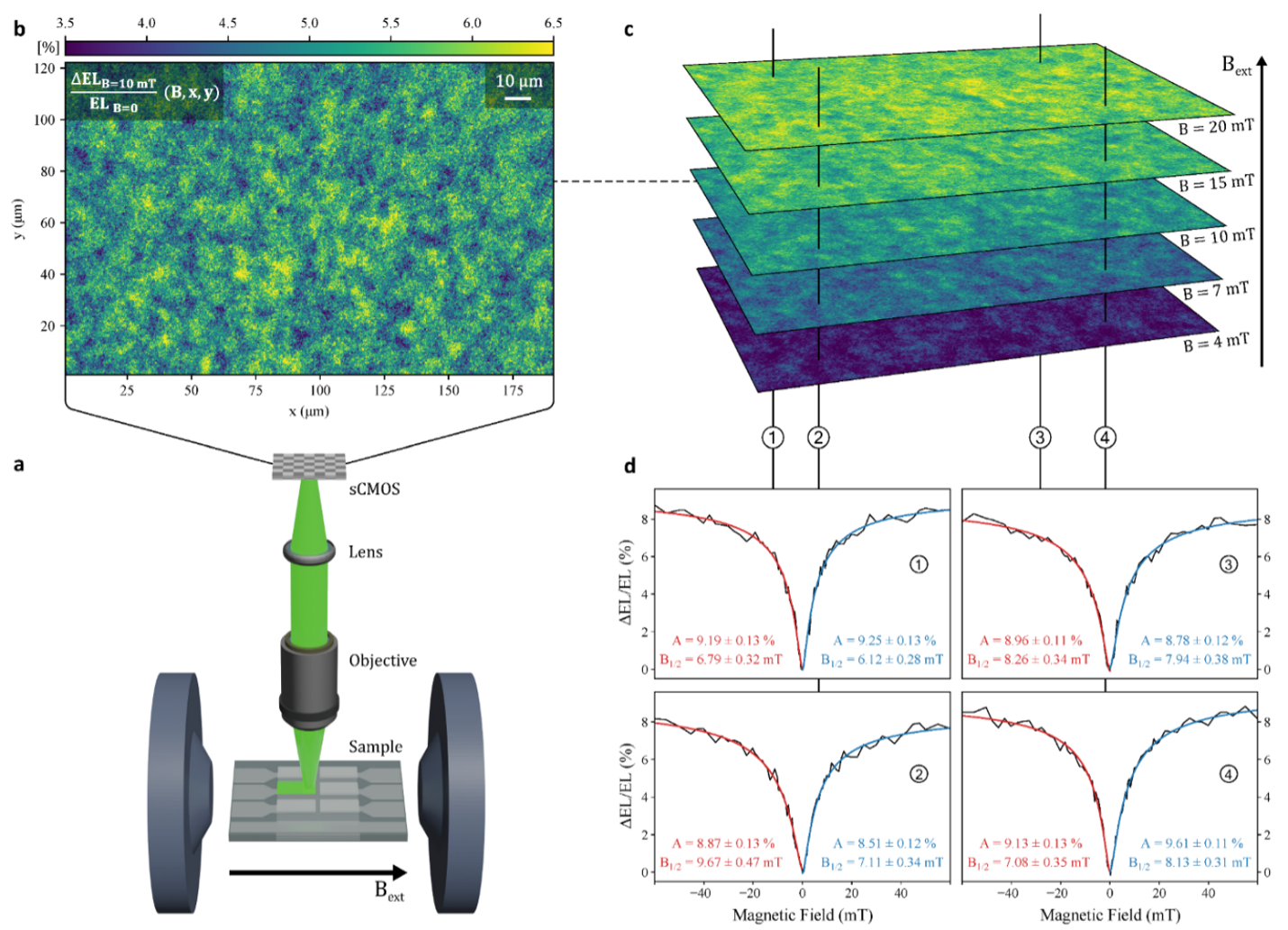
Sketch of the experimental approach (a) to measuring variation (b,c) and correlation of quantum properties in OELDs via spatially resolved magneto-luminescence measurements (d).

Photo of the new ultrafast laser system installed at UniMelb.
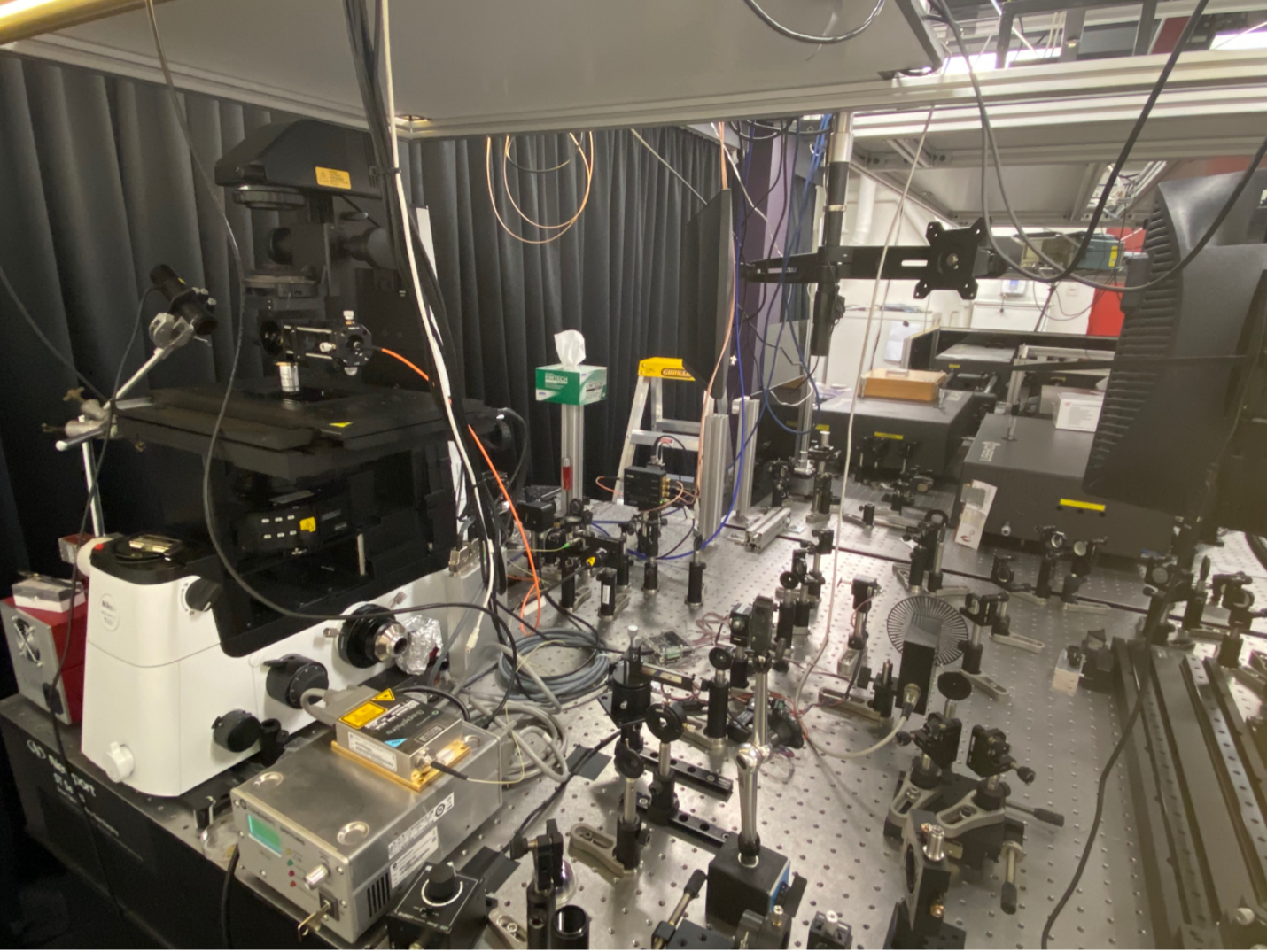
Photo of the Transient Absorption Microscope.
Platform 2.2 - Excitons at Interfaces
Platform Leader: Alison Funston
Deputy Platform Leader: Asaph Widmer-Cooper
Exciton dynamics in materials and across hybrid interfaces are highly complex and are dependent on the nanoscale morphology, spin polarisation, exciton manifold and interfacial density of states.
Our aim is to understand how these parameters control the exciton dynamics in assemblies of organic-inorganic hybrid systems.
These parameters are not observable by conventional optical methods and require super-resolution and single molecule fluorescence techniques to probe below the diffraction limit of light.
We have developed a large number of nanocrystal assembly methods that allow different types of nanoparticles to be ordered and co-ordered into structures with a wide variety of geometries.
The forces underpinning these assembly methods, including the role of polymer depletion and the influence of molecular ligands on the colloidal stability of nanoparticles, are now well understood.
Exciton processes, including lifetime control, emission spectra, and exciton transfer have been measured and theoretically understood.
Instruments with sub-diffraction limit spatial resolution and picosecond temporal resolution have been developed. Spatially-resolved transient absorption, as well as emission anisotropy, have also been developed.
Work on quantum wells and perovskite interfaces is progressing well.
People
Chief Investigators
| Name | Node |
|---|---|
| Ken Ghiggino | University of Melbourne |
| Timothy Schmidt | UNSW Sydne |
| Asaph Widmer-Cooper | University of Sydney |
| Paul Mulvaney | University of Melbourne |
| Dane McCamey | UNSW Sydney |
| Jared Cole | RMIT University |
| Trevor Smith | University of Melbourne |
| Wallace Wong | University of Melbourne |
| Girish Lakhwani | University of Sydney |
| Alison Funston | Monash University |
| Jacek Jasieniak | Monash University |
Partner Investigators
| Name | Node |
|---|---|
| Anthony Chesman | CSIRO |
Associate Investigators
| Name | Node |
|---|---|
| Ivan Kassal | University of Sydney |
| Kavan Modi | Monash University |
Postdoctoral Research Fellows
| Name | Node |
|---|---|
| Nicholas Kirkwood | University of Melbourne |
| Tian Zhang | Monash University |
| Anchal Yadav | Monash University |
| Fei Zheng | University of Melbourne |
| Gangcheng Yuan | Monash University |
| Harini Hapuarachchi | RMIT University |
| Mykhailo Klymenko | RMIT University |
| Yawei Liu | University of Sydney |
| Laszlo Frazer | Monash University |
Postgraduate students
| Name | Node |
|---|---|
| Arun Ashokan | University of Melbourne |
| Cameron Dover | UNSW Sydney |
| Jiho Han | University of Melbourne |
| Mayank Bhasin | University of Melbourne |
| Daniel Balzer | University of Sydney |
| William Pappas | UNSW Sydney |
| Hugh Sullivan | RMIT University |
| Roberto N. Muñoz | Monash University |
| Subhajit Chakraborty | University of Melbourne |
| Sakuya Mori | University of Melbourne |
| Nicholas Sloane | UNSW Sydney |
| Anum Nisar | Monash University |
| Jared Wood | University of Sydney |
| Minh Triet Nguyen | UNSW Sydney |
| Patrycja Ballard | Monash University |
| Fangfang Yuan | University of Melbourne |
| Conor Day | University of Melbourne |
| Samantha Zaman | University of Melbourne |
| Mohammad Rashedul Hasan | University of Sydney |
| Shon Kolomoisky | Monash University |
| Yihan Dong | University of Melbourne |
| Yan Wu | University of Melbourne |
| Jiakai Wang | University of Melbourne |
| Zifei Chen | University of Melbourne |
| Ben Tadgell | University of Melbourne |
| Irina Zharinova | University of Melbourne |
| Dingchen Wen | University of Melbourne |
Progress towards Project Scope
Spectroscopic characterisation of coupling in multi-chromophoric exciton system
Excitons in polymers: Time-resolved transient absorption microscopy and time-resolved confocal fluorescence anisotropy imaging techniques have been developed allowing the photophysics and emission polarisation in polymer-based films to be mapped with high spatial and temporal resolution. Morphological requirements for nanoscale charge accumulation in polymer donor-acceptor polymer films indicate that electric field effect can be turned on and off by changing the blend film nanomorphology.
Excitons in crystals: Time-resolved transient absorption microscopy with μm spatial resolution and 25 ps time resolution developed and operational. Time-resolved confocal fluorescence anisotropy imaging techniques developed.
Exciton harvesting and directed transfer, including excitonic states in molecules and nanostructures, interactions and dissipation
Excitons in Quantum Dot-Quantum Dot Assemblies: Homo-QD-QD dimers and structures assembled which show splitting of emission spectra suggestive of electronic interaction. Implementation of theory to explain observed spectral splitting in QD-QD systems is underway. QD-QD assemblies which undergo energy transfer with 78% efficiency (at interparticle separation of 10 nm) formed, including multiple donor-single acceptor systems. Progress to expand to deposited, closely situated nanoparticle assemblies delayed.
Control of QD lifetimes: Nanocavity effects in QD-Localised Surface Plasmon Resonance (LSPR) systems with small interparticle separations (<1 nm) resulting in up to a three-fold increase in the lifetime of the QD coupled to metal nanoparticles observed. Closely situated QD-QD dimers and higher assemblies show QD lifetime lengthening of approximately 2.6-fold. Development of theory to explain/predict optical properties of strongly coupled metal nanoparticle-QD systems underway.
QDs in cavities: Nanocavities incorporating only one QD assembled. Spectra indicate possible effects of being in the strong-coupling regime.
Excitonic behaviour and transport at organic-inorganic or inorganic-inorganic interfaces
Energy transfer across organic-inorganic interfaces: Efficient energy transfer, up to 91%, from QD to bulky perylenediimide dye chromophores, packed at high packing density on QD surface achieved. Up to 138 PDI molecules can be bound on the QD surface with retention of colloidal stability. Methods to model chromophoric ligands on nanoparticles to begin in 2022.
Arrays of QD-organic structures – synthesis, energy transfer and trap states in layered films
Excitons in aligned films: Prediction of conditions required for self-assembly of close-packed nanorod mono- and multi-layers achieved. Prediction of conditions required for self-assembly of binary nanorod superlattices with potential to undergo energy transfer. Driving forces responsible for electrophoretic deposition of nanoparticles elucidated.
Exciton diffusion in 2D QD films: Instrumental conditions optimised to give picosecond time resolution and 150 nm spatial resolution. Time-resolved data collected for diffusion across films measured for 2D monolayers and doped monolayers.
Exciton diffusion in QD assemblies: Assemblies of nanoplatelets formed.
Excitons in layered QD films: Energy transfer in tri-layer, multi-material (CdSe, CdTe, CuInS2) QD films observed and quantified from highest bandgap to lowest bandgap, with absorption/emission across the visible region and into the NIR. Film morphologies achieved best for most monodisperse QDs in initial templating layer.
Exciton transfer from a 2D film to organics: Emissive InGaAs quantum wells formed and emission able to be tuned by well thickness.
Alignment and mobility of chromophores on nanoparticles
Ligand effects on colloidal stability: Colloidal stability of apolar nanoparticles in solvent mixtures has been characterised using SAXS and SANS and non-linear trends explained using MD simulations.
Chromophores on QDs: Chromophores functionalised onto silica-coated metal nanoparticles used to image optically nanocubes approximately 100 nm in size using dSTORM, showing sufficient chromophore density. Effects of chromophore density on dSTORM imaging quality explored.
Interface Processes in Perovskites
Excitons at perovskite interfaces: Phase distribution model established to describe the bidirectional exciton funneling to both sides of the quasi-2D perovskite films for the generation of free carriers. Time-resolved confocal fluorescence anisotropy imaging techniques developed. Photocurrent mapping yet to be incorporated.
Controlled Engineering of Interfaces (quantum wells).
Quantum Wells: CdSe/CdS, doped CdSe/CdS and InGaAs quantum wells synthesised with good control of emission. Assembly of quantum wells into layers/1D stacks achieved.
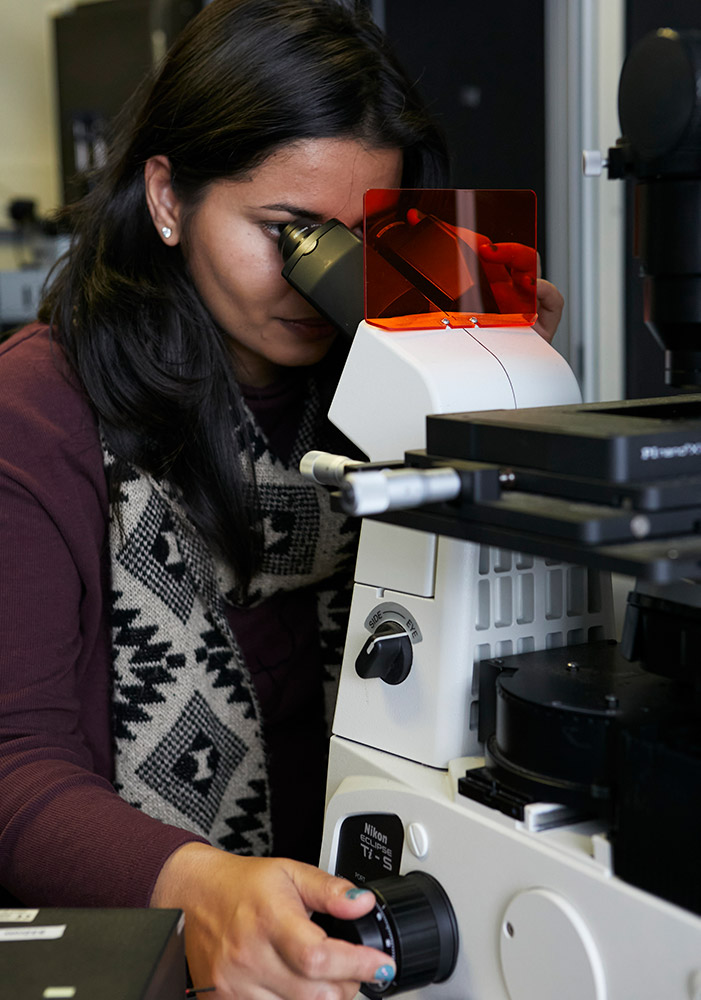
Progress update in 2021
Construct single molecule devices and functional nanostructures.
- achievement of this first goal requires bringing knowledge of nanocrystal synthesis, assembly and the individual and coupled nanoparticle optical response together in a designed way to form functional nanostructures.
- construction of single molecule devices and/or functional nanostructures requires methods for the controlled formation of nanocrystal assemblies, both at small distances and in larger arrays. Progress towards the formation of such devices is very good, with a large number of nanocrystal assembly methods built up across different nanoparticle types, and different assembly types (for example - discrete structures, 2D arrays, aligned 2D arrays), including DNA-based self-assembly and electrophoretic deposition. The forces underpinning these assembly methods, along with polymer depletion methods and the colloidal stability of nanoparticles are well understood.
- design and construct interfaces to control the localisation and lifetime of excitons by:
- determining parameters that control the exciton diffusion in single molecules and single nanocrystals of multichromophoric systems.
- determining the factors that govern exciton dynamics across inorganic-inorganic and organic-inorganic hybrid interfaces.
- measuring the impact of spin mixing of singlet and triplet exciton states on energy and charge transfer across hybrid interfaces.
- exciton processes, including lifetime control, emission spectra, and exciton transfer in a vast range of nanoparticle-based structures and assemblies - including single nanocrystals, those containing inorganic-inorganic interfaces, energy transfer systems (both inorganic-organic and inorganic-inorganic) - have been measured and theoretically understood.
Develop novel optical probes to study energy transfer
- work across many platforms within the Centre has been supported by this aim. Instruments with sub-diffraction limit spatial resolution and picosecond temporal resolution have been developed. Spatially-resolved transient absorption, as well as emission anisotropy have also been developed. Further development and improvement of these facilities will continue throughout the lifetime of the Centre.
- optimise interfaces via band-edge engineering and passivation to:
- achieve triplet injection into PV relevant materials.
- understand and control fundamental interface processes.
- research into exciton processes at interfaces relevant to the Centre continues. While one aspect of this aim has been delayed (achieve triplet injection into PV relevant materials), work on quantum wells and perovskite interfaces is progressing well.
Risk and Mitigation
Progress in this platform has been slower throughout the COVID pandemic, with some aims for 2020/2021 delayed as access to laboratories has been interrupted. Isolation of students during lockdowns and an inability to meet others in the Centre face-to-face has also played a role in the delays. While this has been mitigated as much as possible by holding regular seminars and group/collaborative meetings via zoom, conversation via these platforms is more stilted.
We anticipate the effects of the lockdown will lessen going into 2022 (assuming no significant changes in the COVID situation). However, combined with this is the break in the pipeline of PhD students due to difficulties recruiting students internationally during COVID, as well as difficulty hiring postdoctoral researchers internationally. The latter will be offset by the availability of Centre-wide postdoctoral schemes.
Industry Collaborations
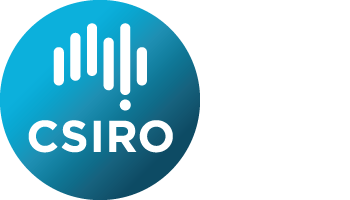
International Participation
Prof. Xiaotao Hao (PI, Shandong University) on exciton transport at perovskite interfaces, with CI Ken Ghiggino.
Prof Köhler (PI, Bayreuth University) working on new excitonic materials for OPV and exciton diffusion studies, with Mulvaney.
Nanocrystal growth with Bayreuth and Forschungszentrum Jülich (Mulvaney).
Prof Colfen (Konstanz University) on ultracentrifugation studies of CdSe QDS with Mulvaney.
Prof Weber (University of Colorado Boulder, USA) on high pressure studies of QDs and Prof Rodriguez (Santander, Spain) on high pressure studies of Gold NCS with Mulvaney.
Prof. Anindya Datta (IIT Bombay, India) on ultrafast dynamics of assembled nanosctructures, with CI Alison Funston.
Prof Tobias Kraus (Leibnitz Institute for New Materials, Germany) on the colloidal stability of nanoparticles with CI Asaph Widmer-Cooper.
IRTG submitted for funding of 10 joint PhD students between Bayreuth and Melb/Monash in 2020.
Outlook to 2022
A key opportunity early in 2022 for the platform will be to identify, design and begin work on concepts for single molecule devices and functional nanostructures. This is anticipated to be highly collaborative and will potentially bring together a number of individual self-assembly techniques.
Research Highlights in 2021
Shape Matters
Modulation of the photoluminescence (and photoluminescence lifetime) of CdSe/CdS 3D confined quantum dots and 1D confined nanoplatelets using spectroelectrochemistry has been shown.
The response of these nanocrystals to an electrochemical potential showed that the underlying multicarrier dynamics within luminescent semiconductor nanocrystals are dictated by the confinement.
For 3D confinement, hole injection quenches the photoluminescence, while for 1D confined crystals, hole injection results in photoluminescent brightening due to reduction of the negative trion.
The emission lifetime of the nanocrystals is modulated by the applied potential, confirming the involvement of Auger recombination.
In a similar vein, the orientation of the emission dipole of these materials, along with 2D confined quantum rods, is related to the shape affected confinement.
While a linear emission dipole is found for 2D confined nanorods as expected, for nanoplatelets, with both 2D and 1D confinement the emission dipole is not linear, but 2D.
The origin of isotropic and anisotropic emission is from the electronic structure of nanocrystals, in turn dictated by their different shapes and lattice structure.
The quantum dots and quantum rods are wurtzite phase, while the nanoplatelets are zinc blende, with the latter combination in 2D confined crystals leading to a more anisotropic emission.
Doping of the nanoplatelets with silver or copper leads to the formation of localized in-gap states leading to an additional red-shifted peak in their emission spectra.
The 1D nature of the nanoplatelets also facilitates their face-to-face assembly over large areas and this has been achieved.
(Mulvaney, Funston, Cole, Jasieniak)
Carrier Funnelling in 2D Perovskite Films
Perovskite solar cells based on quasi-2D perovskite structures, called Ruddlesden–Popper perovskites (RPPs), are promising for their performance and stability, as well as their potential for printing-based fabrication.
In order to improve the photovoltaic efficiency of quasi-2D perovskite films, a greater understanding of how film structure affects charge carrier generation and collection is required.
This has been achieved using photophysical and structural characterisation of the films.
Crystallisation of the films leads to a sandwich-like structure, with larger RPPs at the top and bottom of the film, and smaller RPPs sandwiched between these.
Quantitative analysis based on the transient absorption spectra shows both that the large RPPs phase layer on the bottom of the quasi-2D perovskite film is much thinner than that on the top of the film, and that the smaller and larger RPPs are bridged by intermediate RRPs.
This structure leads to a fusiform-like bandgap diagram for the films, with bidirectional exciton funneling to the top and bottom generating free carriers at the film surfaces.
The formation and role of Brownian tree-shaped dendrites in the MACl doped films was explored, and these were found to enhance efficiency. Ageing the quasi-2D perovskite films in N2 was found to lead to compositional and structural refinement.
These results pave the way towards further optimization of the performance of quasi-2D perovskite-based optoelectronic devices by rationally manipulating the thickness ratio of each RPP phase layer, and therefore the bandgap across the film.
(Ghiggino, Smith, Gao (CSIRO))
Scientists take a bite out of solar efficiency challenge with sandwich model
Read more...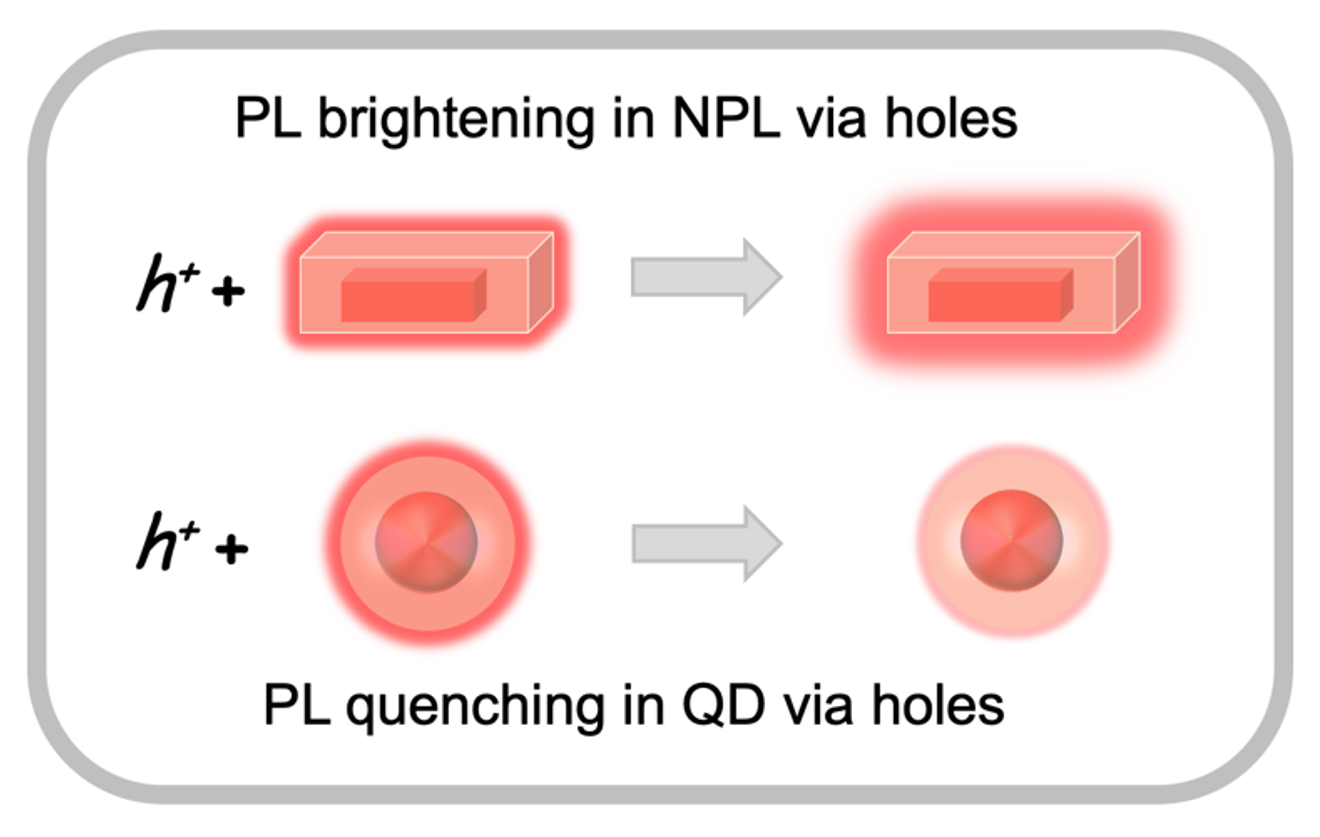
Schematic showing photoluminescence brightening of CdSe/CdS nanoplatelets and photoluminescence quenching of CdSe/CdS quantum dots upon introduction of holes via application of a positive electrochemical potential.

Photoluminescence spectra of CdSe/CdS nanoplatelets upon application of a positive electrochemical potential.
Platform 2.3 - Multi scale models of exciton transport
Platform Leader: Jared Cole
Deputy Platform Leader: Salvy Russo
Exciton dynamics in materials and across hybrid interfaces are highly complex and are dependent on nanoscale morphology, spin polarisation and vibrational properties. The aim of this platform is to develop computational modelling techniques to understand the exciton dynamics in single molecules or organic-inorganic hybrid systems.
In this platform, we employ a combination of different theoretical approaches to examine the interplay between electronic coupling, spin and structure on exciton diffusion and delocalisation in disordered organic and hybrid materials on scales ranging from the atomistic to the device level.
Our work to develop multiscale computational methods that can help interpret and predict exciton behaviour from the nanoscale to the device level is reaching maturity and producing valuable results.
We have now made five software packages freely available for the global community of researchers and other users to access. Productive collaborations continues within the Centre, elsewhere in Australia and with our partners in the UK, USA, Sweden, Switzerland and Germany.
People
Chief Investigators
| Name | Node |
|---|---|
| Ken Ghiggino | University of Melbourne |
| Salvy Russo | RMIT University |
| Asaph Widmer-Cooper | University of Sydney |
| Paul Mulvaney | University of Melbourne |
| Dane McCamey | UNSW Sydney |
| Jared Cole | RMIT University |
| Trevor Smith | University of Melbourne |
| Wallace Wong | University of Melbourne |
| Alison Funston | Monash University |
| Girish Lakhwani | University of Sydney |
| Udo Bach | Monash University |
Associate Investigators
| Name | Node |
|---|---|
| Sherif Abdulkader Tawfik Abbas | Deakin University |
| Kavan Modi | Monash University |
| Ivan Kassal | University of Sydney |
| Anna Köhler | University of Bayreuth |
| Lars Goerigk | University of Melbourne |
| Tu Le | RMIT University |
Postdoctoral Research Fellows
| Name | Node |
|---|---|
| Stefano Bernardi | University of Sydney |
| Igor Lyskov | RMIT University |
| Nastaran Meftahi | RMIT University |
| Mykhailo Klymenko | RMIT University |
| Jamie Booth | RMIT University |
| Martin Cyster | RMIT University |
| Mahyar Madadi | University of Melbourne |
| Francesco Campaioli | RMIT University |
| Alicia Schuitemaker | University of Sydney |
Postgraduate students
| Name | Node |
|---|---|
| Michael Rinaudo | University of Sydney |
| Daniel Balzer | University of Sydney |
| Sakuya Mori | University of Melbourne |
| Anjay Manian | RMIT University |
| Carl Belle | RMIT University |
| Jesse Vaitkus | RMIT University |
Progress towards Project Scope
Exciton dynamics in materials and across hybrid interfaces are highly complex and are dependent on the nanoscale morphology, spin polarisation and vibrational properties. The aim of this platform is to develop computational modelling techniques to understand exciton dynamics in single molecules or organic-inorganic hybrid systems, all the way up to the device level.
The central work of this platform is to develop methods and approaches which are then used to tackle the problems in the other platforms of the Centre. Much of this development work is done by postdocs, with the resulting methods and code being used by students and collaborators.
During 2021, at least 21 papers have published or accepted as part of the projects within this platform. In addition, several new software packages have been released for public access and/or published in computational modelling journals. During this year, 11 postdocs worked on projects within this platform, as well as at least seven students whose work depends on the methods being developed.
Progress update in 2021
The key goals of Platform 2.3 revolve around developing new simulation tools and applying them to problems of interest to the Centre. The first years of the Centre therefore involved quite a lot of mathematical and software development. In the last 12 months, this work has really come to fruition with a series of papers and software packages being released.
Importantly, all the software packages developed within this platform are freely available for the community to use. These include:
Risk and Mitigation
Although COVID-19 has not limited this platform in terms of lab access, isolation of researchers during lockdown has reduced collaboration. This has been addressed via online group meetings and in-person events where possible.
Towards the end of 2021, Igor Lyskov has left the RMIT team to pursue a new position in Russia. This leaves a significant gap in MRCI/DFT expertise. Anjay Manian has been working closely with Igor and has been employed to fill this gap.
Jesse Vaitkus was employed to complete Boltzmann transport simulations at the start of 2021, working with RMIT (JHC) and UNSW (DM) on the silicon nanowire project. Jesse moved to Germany in May 2021 to join our collaborators at HQS Quantum Simulations. The remaining part of the work for this project will be performed in early 2022 by another member of the RMIT team.
Industry Collaborations

HQS Quantum Simulations
HQS provides software for materials scientists in the chemical industry, as well as in academia. Sophisticated quantum-level models of materials and their molecular properties give researchers the deeper insights they need to identify the ideal solution for their needs.
International Participation
Per Delsing, Department of Microtechnology and Nanoscience, Chalmers University of Technology, Gothenburg, Sweden.
Liang Tan, Theory of Nanostructured Materials, Lawrence Berkeley National Lab, USA.
Robert Shaw, Department of Chemistry, University of Sheffield, Sheffield, United Kingdom.
Jochen Feldmann, Physics & Nanosystems Initiative München (NIM), Ludwig Maximilians Universität, Munich, Germany.
Yinyin Bao, Institute of Pharmaceutical Science, ETH Zurich, Zürich, Switzerland.
Outlook to 2022
The outlook so far for 2022 is very good. We have a largely unchanged personnel situation (other than the departure of Igor Lyskov and Jesse Vaitkus, as discussed). Most methods development within this platform has either been completed or is close to being finalised. Therefore, the focus in 2022 will involve applying these methods to problems of interest to the Centre.
Research Highlights in 2021
Machine learning for solar energy is supercomputer kryptonite
Read more...The USyd team (AW-C) have developed a versatile method for including hydrodynamic effects when simulating nanoparticle motion and assembly in solution. This method models both spherical and rod-shaped nanoparticles and has been applied to understand the origin of nanorod alignment during electrophoretic deposition.
Y Liu, A Widmer-Cooper, Journal of Chemical Physics 154, 104120 (2021)
The USyd team (AW-C) have continued to study the stability of mixed-halide perovskites in response to light and heat. The original 2D lattice model developed in 2020 has been extended to 3D and can now also handle halide vacancies. This model will be further extended to include a more realistic description of exciton diffusion.
Mao et al., Nature Materials 20, 55-61 (2021)
The RMIT team (SPR) have developed an abinitio methods to predict Photoluminescence (PL) Spectra. One method is based on TD-DFT of clusters with Huang-Rhys factor frequency constraints. The other method is based on constrained DFT with periodic boundary conditions. Both methods show good performance when compared to experimental results. New software code `PyPhotonics’ released freely accessible to the community on GitHub.
Karim et al., Journal of Applied Physics, 128, 233102 (2020)
Tawfik and Russo, PyPhotonics: A python package for the evaluation of luminescence properties of defects, Computer Physics Communications, 273, 108222 (2022)
Karim et al., Journal of Applied Physics (2021 under review)
The RMIT team (SPR) in collaboration with Sherif Abbas (now at Deakin University) continues to develop machine learning software tools and methods for materials design. This includes two new software packages
- Hodoken: Universal band-gap simulator based on machine learning on 30,000 compounds.
- Crystal Features: Using DFT (PBE) band-gap able to predict band-gap of a higher accuracy method (GW Approximation) – collaboration with S. Abbas (Deakin).
Using these packages and other techniques, the team have developed robust single-shot abinitio (RSSA) descriptors based on low level DFT. They have also demonstrated high accuracy using RSSA in predicting properties for metals and semiconductors; including electronic, mechanical and vibrational quantities, high precision bandgaps (HSE, GW) and exciton binding energies.
Meftahi et al., npj Computational Materials volume 6, Article number: 166 (2020)
Belle et al. Journal of Cheminformatics, 13(1), 1-23 (2021)
The RMIT team (SPR) have studied molecular relaxation pathways in excitonic molecules. They have developed methods to model relaxation pathways within Franck-Condon and Herzberg-Teller approximations. The pathways considered include: fluorescence, inter-system crossing, internal conversion, singlet fission (under development) and strong solute-solvent interactions (under development).
Manian et al. J. Chem. Phys. 155, 054108 (2021)
Shaw et al. J. Chem. Phys. 154, 084102 (2021)
The RMIT/Monash/Deakin teams (SPR & JJ & SA) have developed a Multiscale model of Photovoltaic Devices using toolkit software CrystalFeatures and PyPhotonics (developed at RMIT) to predict material properties (based on DFT) and device properties (COSMOL). This was funded through the Centre cross-node postdoc scheme.
The RMIT team (SPR & JHC) studied the movement of singlet exciton dynamics in luminescent solar concentrators by computing rate constants calculated using TD-DFT/DFT-MRCI and then dynamics using Kinetic Monte Carlo. The example system was a hetero/homogeneous substrate using PDI and Tetracene chromophores. Statistics were found comparable to experimental transport properties. In addition, a "singlet-bus" transport mechanism was identified, where triplet excitons can be recycled into singlet excitons and ride the bus to get harvested. Subsequent work is under way to study the role of agglomeration in this system (Campaioli et al.).
Manian et al., J. Phys. Chem. C 125, 43, 23646–23656 (2021)
The RMIT team (JHC & SPR) developed a semiconductor Bloch equation method to model the optical properties of photovoltaic materials. This approach gives excellent agreement with the experimental optical gap, and also agrees closely with the excitonic stabilisation energy and the absorption spectrum, while being equally accurate as the Bethe-Salpeter Equation (BSE) approach which is far more computationally expensive. The test case of studying the excitonic properties of BiSBr showed that this approach can be used for quasi-one-dimensional materials.
Booth et al., Phys. Rev. B 103, 115203 (2021)
The RMIT team (JHC) have developed a method for studying the movement of excitons in polymer organic semiconductors. This approach generalises conventional master equation approaches, including the effects of delocalisation, disorder and charge separation. This technique was applied to exciton transport and dissociation in poly(p-phenylene vinylene) as a function of conformation and temperature. This approach is currently being adapted to use multi-scale modelling from molecular dynamics (USyd, AW-C) and MRCI/DFT (RMIT, SPR) as inputs to the simulation.
Campaioli and Cole, New Journal of Physics, 23, 113038 (2021)
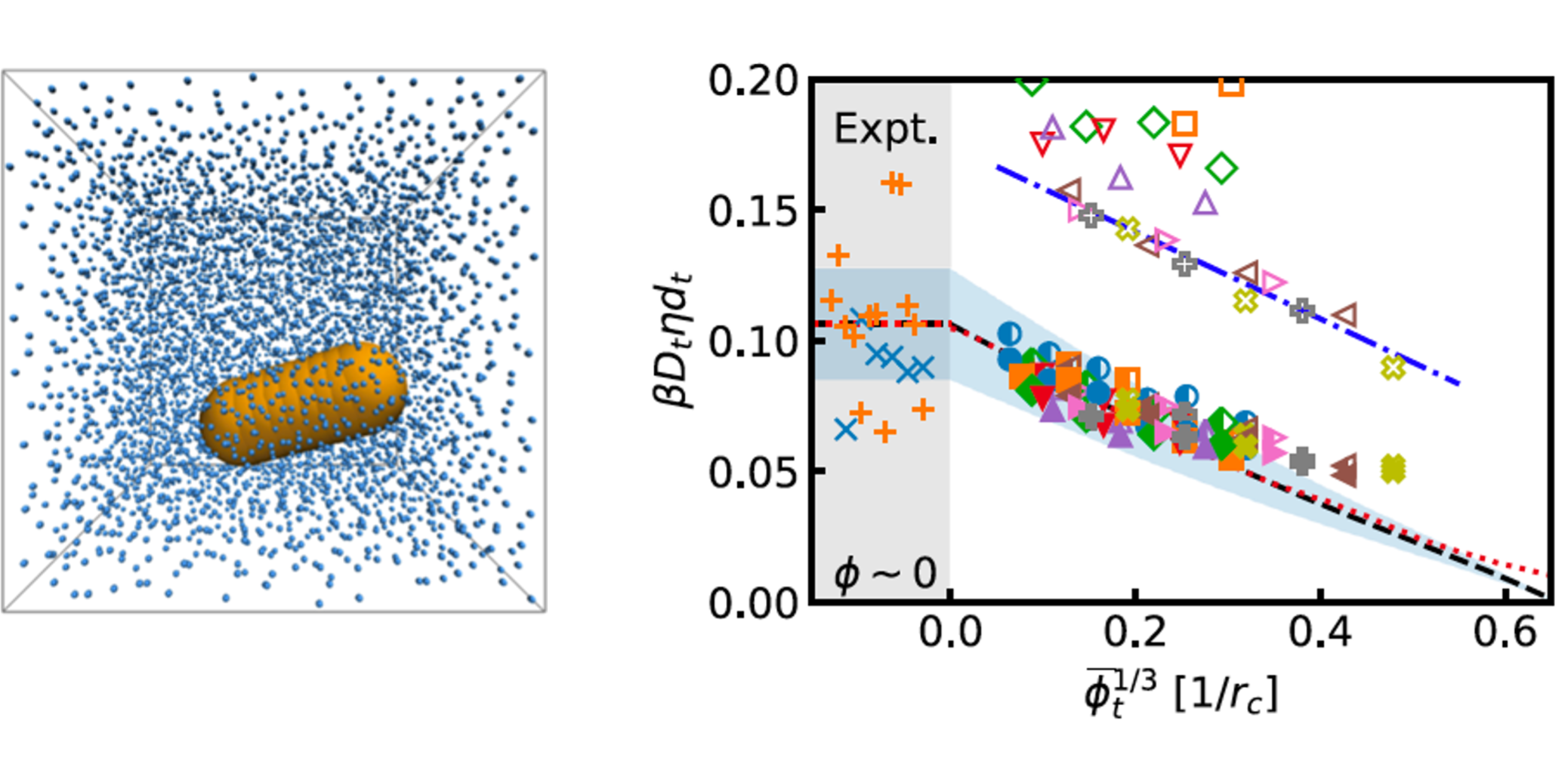
(left) Coarse-grained nanorod and solvent. (right) Translational diffusion constant as a function of concentration compared with theory and experimental data. Results are shown for both slip (open symbols) and stick (closed and half-filled symbols) boundary conditions.
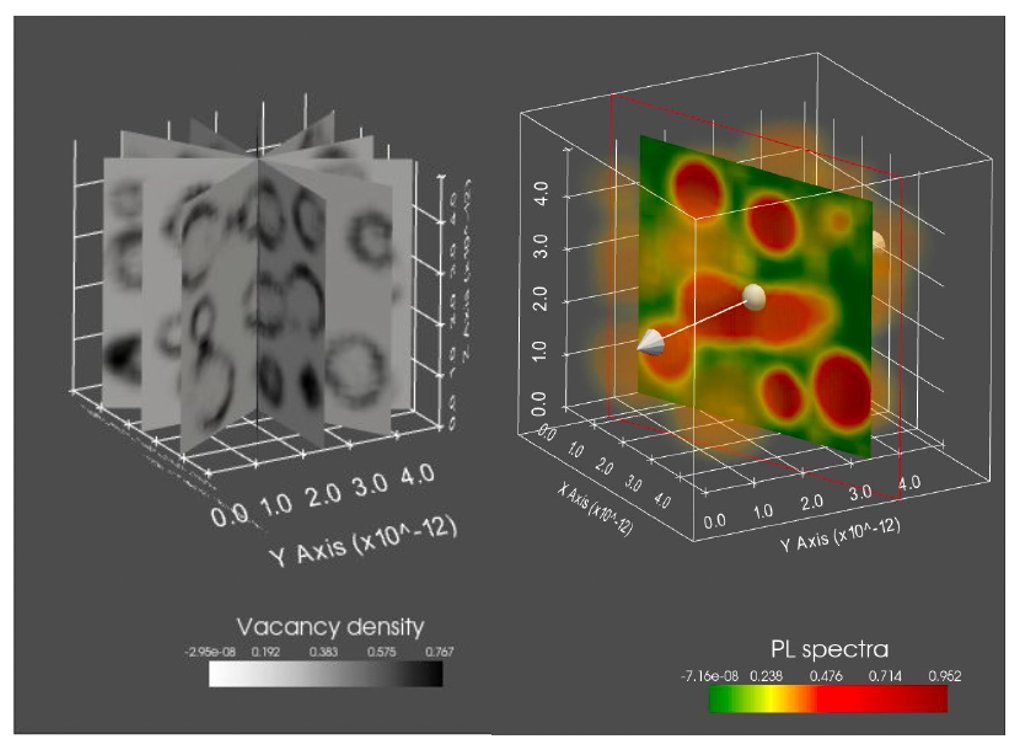
The lattice model of mixed-halide perovskites in response to heat and light. The model has been extended from 2D to 3D. The ability to handle vacancies has also been added.
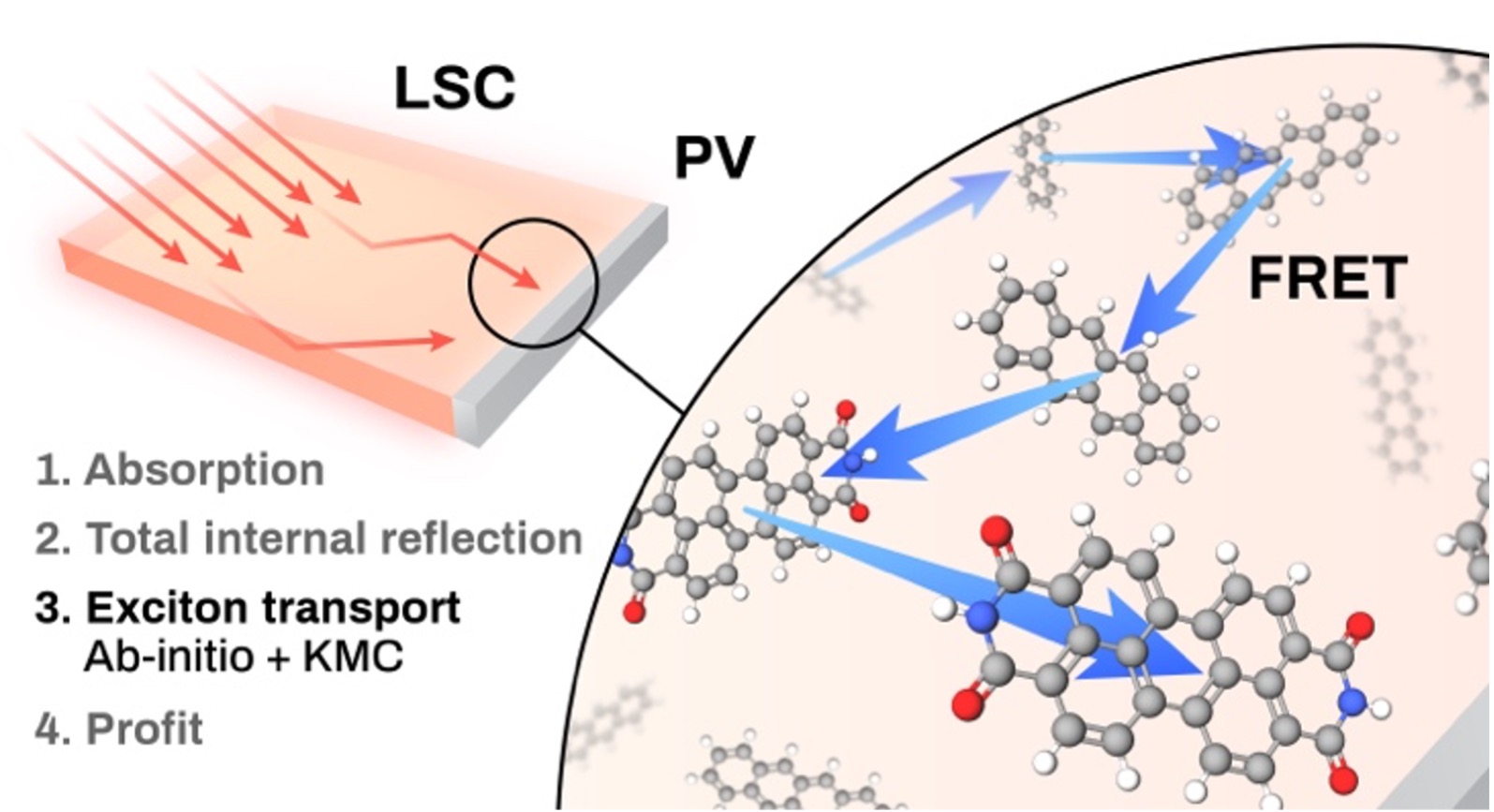
Understanding exciton movement in luminescent solar concentrators. Triplet excitons can be recycled into singlet excitons and ride the bus to get harvested.
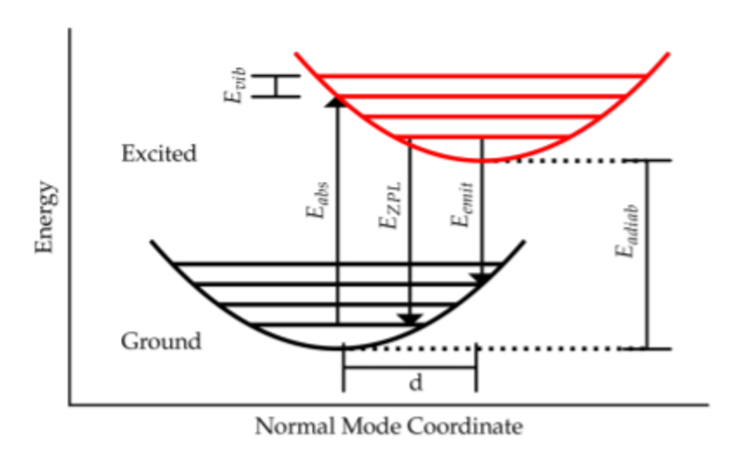
The displaced harmonic oscillator model (DHO) along one normal coordinate. The potential energy surface is shown as parabolae. Solid horizontal lines denote vibrational energy levels. The displacement on excitation along this mode is D. In the DHO model, the parabolae are identical but shifted by D.

Photoluminescence spec1rum of an NV- center in a C197NH140 nanodiamond with frequency cutoffs at 357 cm-1 (blue dotted) and 469 cm-1 (red dashed) and without any cutoff applied (cyan). Experimental spectrum of solid state NV- is reproduced with permission from Aslam et al., New J. Phys. 15, 013064 (2013). Copyright 2013 IOP Publishing.
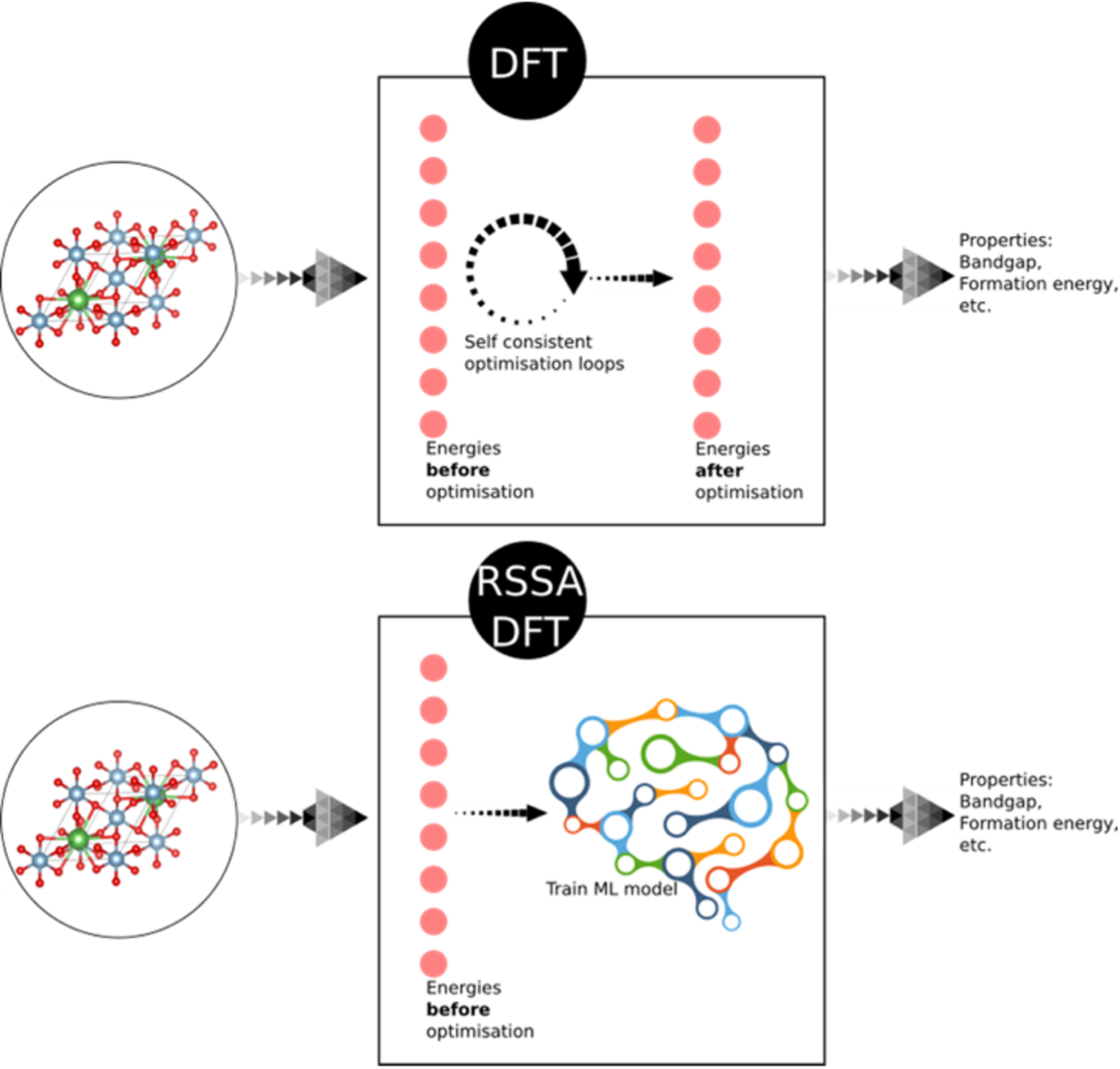
A schematic illustration of the RSSA DFT concept. An ordinary DFT calculation, in which two self-consistent optimization loops determine the electronic structure of the ground state system. The lower figure shows how RSSA DFT approximates the properties of the ground state system: it extracts the system “Energies” before optimization, and uses that to train a machine learning model to predict the desired properties.

Hadoken GUI interface for machine learning based materials discovery

Phenomenological solute-solvent models and their effects on low-lying electronic excited states on highly solvatochromic chromophores. Indole shown here emits from the dark in the absence of a high polarity solvent (LEFT). The bright state lowers in energy when Indole is modelled using a dielectric cavity filled with “water” (MIDDLE). Direct Hydrogen-bonding with explicit water solvent molecules (RIGHT) further lowers the energy of the bright state, leading to a bright fluorescence quantum yield of up to 45%.
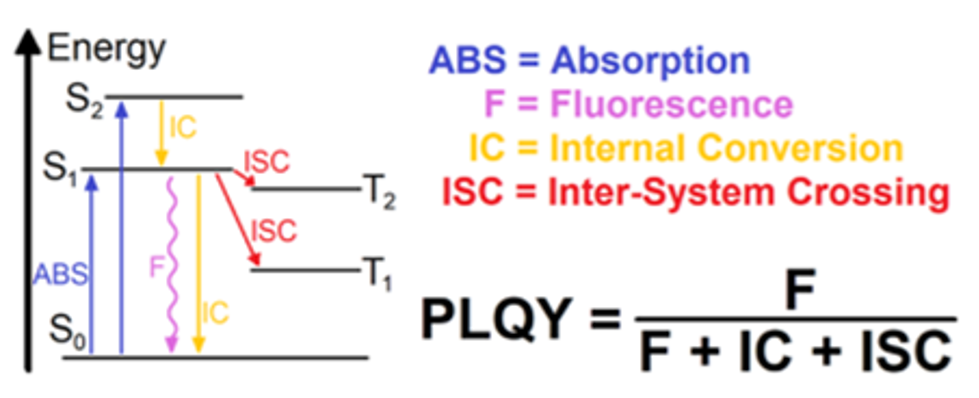
Energy diagram illustrating how the system excites and relaxes. Here, an incident photon excited the ground-state chromosphore to an excited state, be it the first or second singlet excited state. Following relaxation to the ground vibrational state of the first singlet electronic excited state, the energy can transition between nearby electronic excited states.
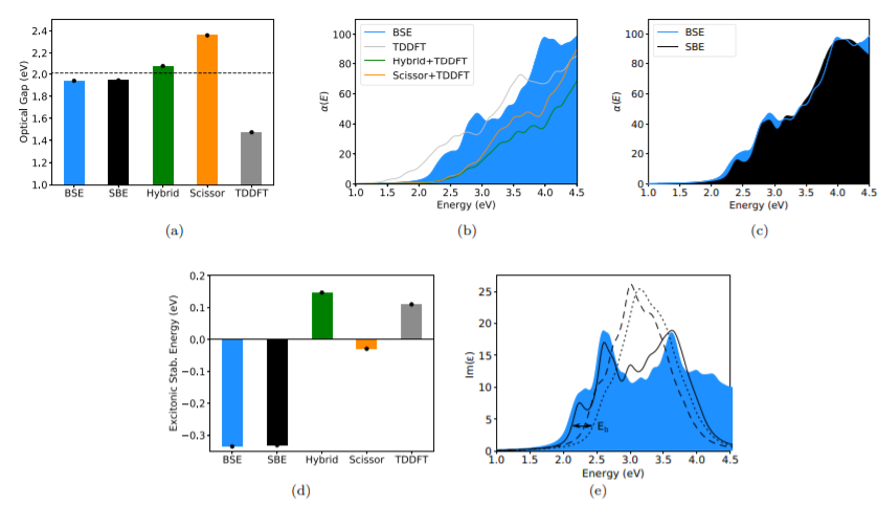
Comparison of the semiconductor Bloch equation approach to other methods for computing the optical properties of BiSBr.
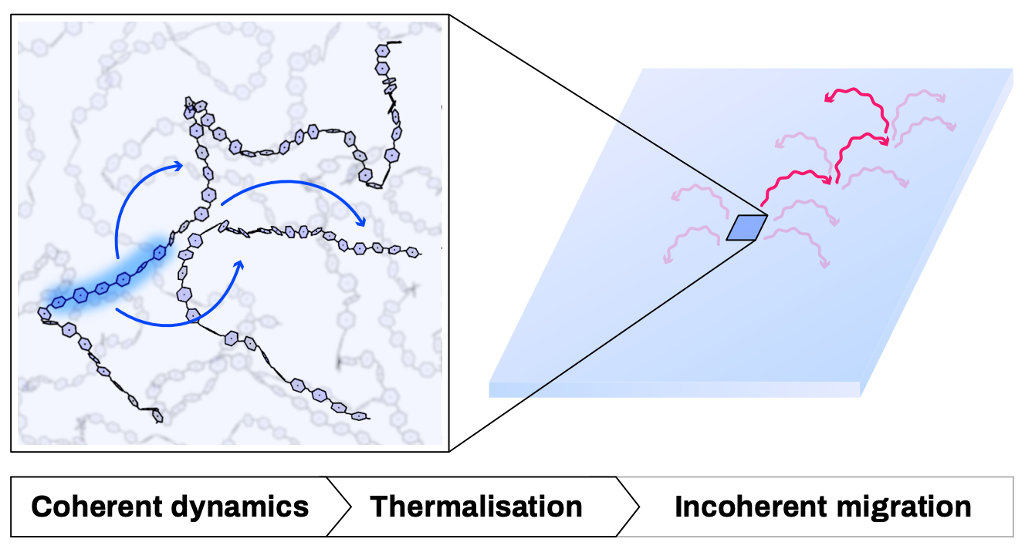
Modelling the flow of excitons in a polymer, where transport along the chain results in coherent delocalisation but then following thermalisation, the movement between chains proceeds via incoherent hopping.

